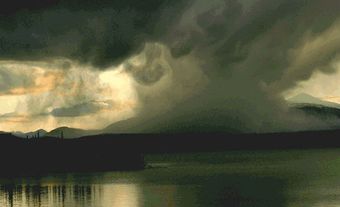Lightning
Lightning, sudden electric discharge that occurs as a giant spark between one portion of an overhead thunderstorm and another portion of the overhead cloud or some point on the ground below. Thunder is the noise such a discharge makes as the air is violently heated along the lightning stroke path. In the absence of clouds, the Earth has a downward-directed, fair-weather electric field, with positive electric charges carried in the air on various ions, and a neutralizing negative charge on the planet's surface.
As a thunderstorm grows, or a mature storm approaches, this electric field is reversed. In general, the lower part of a cloud is negatively charged; the upper portions, positively charged. A further positive charge is induced on the Earth's surface below a thunderstorm. As the storm develops, the electric field within and below the cloud may reach several thousand volts per centimetre, at which stage an electrical breakdown occurs in the form of lightning. A lightning stroke to the ground starts out as a luminous, erratic path of ionized air that proceeds rapidly from the cloud base. As it nears the ground, it is met by an upward-moving column of electric charge originating from some high point on the ground below. On meeting, a violent surge of electric current occurs which constitutes the main stroke. Such lightning is commonly referred to as streak or forked lightning. The sequence of stages is essentially the same when the electrical breakdown occurs between upper and lower portions of the same cloud. In this case the stroke is usually so obscured that only a diffuse flash of light, commonly known as sheet lightning, is seen.
The basic mechanism responsible for thunderstorm charging is the interaction of hail pellets and supercooled water droplets in colder regions of the growing cloud. Collision of these, followed by partial freezing of the latter, results in the ejection of small, positively charged ice splinters; a net negative charge accumulates on the growing hail pellet. Cloud updrafts then complete the process by carrying the small ice crystals towards the cloud top, leaving the negatively charged pellets at lower levels. Within a vigorous and growing thunderstorm, charge separation by these updrafts rapidly rebuilds the electric field following each lightning stroke, so that another can occur from the same cloud region a few minutes later.

 Share on Facebook
Share on Facebook Share on X
Share on X Share by Email
Share by Email Share on Google Classroom
Share on Google Classroom




